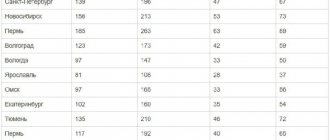In order not to overpay if there is no meter in the apartment, you need to know what standards of electricity consumption are accepted and how to correctly calculate it.
One of the most important types of housing and communal services is electricity. It can be classified in the first category in terms of importance, since most modern equipment cannot work without it.
Dear readers! The article talks about typical ways to resolve legal issues, but each case is individual. If you want to find out how to solve your particular problem , contact a consultant:
+7 (499) 938-81-90 (Moscow)
+7 (812) 467-32-77 (Saint Petersburg)
8 (800) 301-79-36 (Regions)
APPLICATIONS AND CALLS ARE ACCEPTED 24/7 and 7 days a week.
It's fast and FREE !
In Russia, several years ago, rules were adopted that change every year. To perform the calculation correctly, you need to know the current regional indicator.
Important information
The social consumption rate applies to those subscribers who have not yet installed metering devices in their homes.
This is not always due to people's reluctance to install a meter. In some cases, it may not be technically possible to do this: for example, in dilapidated and dilapidated houses. The impossibility of installing equipment must be documented (inspection report). Important: if a person simply does not want to install an electric meter, then increasing coefficients will be used when calculating the cost of the service. For such subscribers, the electricity fee will increase every year. But there are other situations when the calculation will be carried out using this indicator:
- the meter has become unusable;
- the meter has expired;
- apartment residents do not transmit meter readings to the management company and do not allow a representative of the management company to check the meter;
- intentional damage to equipment.
Definition of concepts: what is the social norm for electricity
This is a certain value of electricity consumption calculated for one person. The establishment of the value of the social norm is carried out by each region of the country individually. After its introduction, it is planned to approve two different tariffs for paying for the service:
- within the limits established by the state;
- payment for volumes exceeding this limit.
The tariff accepted for payment of expenses in excess of the limit will be higher than that applied when calculating within the limits of the standards.
Why is the indicator needed?
This is necessary so that the state receives leverage to encourage the population to save light.
And those individuals who do not intend to reduce energy consumption will be forced to pay for the service at a higher cost - approximately at the level of small businesses. The use of these standards will reduce “cross-financing”. What does this mean: a private consumer receives a service at a lower price due to the fact that industrial consumers use energy resources at an inflated cost. Now ordinary citizens pay 1.5-2 times less for energy supplies than businessmen and industrialists.
Basis for determining standards
The assignment of electricity consumption standards is carried out in accordance with the provisions of the following legislative acts (the file will open in a new tab):
- Government Decree No. 614, adopted in July 2017 and defining the rules of social norms for electrical energy. Read more.
- Law No. 35-FZ, adopted in March 2003 with amendments made in 2021 and regulating general issues of electricity supply. Read more.
- Law No. 261-FZ, approved in November 2009 and designed to reduce losses in the energy supply process and promote the introduction of energy-saving technologies. Read more.
Relatively recent adjustments were made in 2013, after which the standards remained unchanged until 2021. As a result of those amendments, the values increased by 10 percent compared to what existed before.
These measures are designed to encourage consumers to install individual metering devices.
Indicator size
Now the rate of electricity consumption is determined by each region independently.
This indicator was previously introduced only in some regions of the Russian Federation. Now it is used throughout Russia.
So, for example, in Moscow, the rate of electricity consumption per person per month, provided that a gas stove is used, is 80 kWh, in St. Petersburg - 78 kWh, in the Perm Territory - 50 kWh, in the Nizhny Novgorod Region - 50 kWh
Important: in the constituent entities of the Russian Federation, changes to the generally accepted meaning are allowed.
Tariff gradation
In order for owners of luxury residential properties to pay for the service at increased rates above the social consumption norm, it is planned to introduce a stepped tariff system, which consists of three levels:
| Basic tariff | from 300 kWh |
| Increased tariff | from 300 to 500 kWh |
| High tariff | over 500 kWh |
It turns out that within the norm, kilowatts are cheaper, and above the norm, they are more expensive. The methodology for determining tariffs is approved by the Federal Tariff Service of the Russian Federation.
Differentiated tariffs by day zones
Electricity consumption in the Nizhny Novgorod, Rostov, and Vladimir regions showed that social the electricity rate can be combined with two-zone and three-zone tariffs with a more fractional grid (day/night and peak/half-peak/night).
Since the redistribution of load on power grids is an important point in the social norm of consumption, differentiated tariffs will not be abolished in 2021.
It is planned to remove some benefits for paying for electricity. So, they are gradually canceling:
- reduced tariffs for rural areas;
- preferential prices for residential properties with electric stoves;
- tariffs for gardening associations, which are equal to prices for citizens.
Instead of preferential tariffs, subsidies are being introduced for beneficiaries in the form of additional payments to benefits . Differentiation will remain depending on the number and composition of residents (benefits for people with disabilities, large families) within the framework of a stepwise payment gradation system.
Standard electricity consumption per person without a meter in 2021
The minimum flow rate is not averaged across the country, but depends on the region, the climatic conditions a person lives in, and the length of daylight hours in that area. However, there are other indicators that are taken into account. These include:
- number of storeys of the building;
- housing size;
- the material from which the building is constructed;
- location of housing - in a city or rural area;
- the number of people registered in the apartment;
- number of rooms in the apartment;
- availability of an elevator and fire-fighting equipment;
- year of construction of the residential building;
- presence of an electric stove.
Electricity consumption by region
Adopted at the legislative level. The indicators depend on what equipment and household appliances are used in the apartment.
| Name of the locality | Consumption rate, kW | |
| gas stove | electric stove | |
| Saint Petersburg | 78 | 111 |
| Transbaikalia | 65 | 96 |
| Novosibirsk | 156 | 213 |
| Vladimir region | 50 | 90 |
| Permian | 185 | 263 |
| Rostov region | 96 | 156 |
It is worth paying attention: the established parameters are less than the social norm. This is done so that Russians are motivated to save light.
Rostov region
This region has its own indicators. In gasified houses, the standard (kW/hour) is:
- for one person - 132;
- on the second - 82;
- on the third - 63;
- on the fourth - 51;
- on the fifth and subsequent ones - 44.
For residential premises where electric stoves are used, special surcharges are provided. Their value is 50 kW/h per person and 90 kW/h for private households.
If houses use electric water heaters, the premium will be 300 kW/h per person.
Seasonal allowances are also provided in this area:
- For the summer months, a coefficient of 1.1 is accepted;
- In February, March and April, subscribers will make payments taking into account the coefficient of 0.9.
Preferential categories of persons pay at a reduced rate. Beneficiaries include:
- citizens of retirement age;
- families raising a disabled child;
- families with disabled people;
- large families;
- citizens raising adopted children.
A caveat: the unused amount of electricity is not carried over to a future reporting period.
Oryol Region
The standard is fixed at an acceptable level - 190 kW/hour for one person, 50 kW/hour is added for the second, 20 kW/hour for the third and fourth.
But if five or more persons are registered in a residential building, then each family member is entitled to an additional 110 kW/hour. The use of additional electrical equipment in an apartment or house will lead to an increase in the amount of energy consumed. In this case, an additional 3000 kW/hour is added per household with an electric boiler during the heating season, 90 kW/hour per person for households with electric stoves, and 100 kW/hour per person for households with electric water heating.
There are also preferential categories of the population, the social norm for which increases by 1.5 times. These include:
- old age or disability pensioners living alone;
- families consisting only of pensioners;
- large families;
- families with disabled people or disabled children;
- substitute families in which children left without parental care live.
Moscow
Moscow has established special energy consumption standards: 50 kW/hour per person in households with gas stoves, and 80 kW for homes with electric stoves.
For the Moscow region these values will be 94 and 144 kW/hour, respectively.
Important: residents of apartment buildings pay not only for their personal use of electricity, but also for general household needs. This fee is mandatory for all subscribers and does not depend on whether the apartment has a meter or not. The amount of payment will depend on the space occupied.
How to calculate using the formula how much you are supposed to pay per month
In order to calculate the payment for electricity, you must use the following formula:
S = K*N*T
The following indicators are substituted into the formula:
| S | Amount paid without metering device |
| K | The total number of people in the family. Only those citizens who are registered in the premises are taken into account |
| N | Current regional indicator |
| T | Tariff for 1 kW |
If you do not use additional powerful equipment, then you can meet the standard established by the Government.
If a citizen consumes more energy than indicated in legal documents, he will have to overpay at a higher tariff.
There is only one way to avoid this - by installing an electricity meter. This will allow you to pay only as you consume.
There are additional conditions that should be taken into account when determining the payment amount:
| If a single pensioner lives in the apartment | In the first year after registration, he only needs to pay at a reduced rate, but from the next year, payment is made according to the current social norm |
| Persons living in the village | They pay at a tariff of 90 kW |
| If the apartment has a stove | Per person consumption rate is 43 kW |
After the meter is installed, payment will occur in full accordance with the data shown by the device.
These indicators should be written down no more than once a month, immediately before repaying the resulting monthly debt.
Video: on this topic
How can you reduce consumption?
To pay less for light, just follow a few simple recommendations:
- replace simple incandescent lamps in housing with energy-saving ones;
- When choosing household appliances, you need to pay attention to its energy consumption class. The most economical would be A or A+++;
- do not turn on the air conditioner with the windows open - this will require more time to cool or heat the room, and, consequently, energy consumption will increase;
- When using an air conditioner, when selecting an operating mode, make sure that the difference between the temperature readings inside and outside is not significant. For example, setting the cooling temperature to 16 °C when the outside temperature is 40 °C or higher would not be a very rational solution;
- It is better to install cooling units (refrigerators, household freezers) where they will receive a minimum of sunlight and heat;
- When using an electric kettle, promptly remove any scale that has formed from it. Otherwise, the water heating time will increase, which means the electricity consumption will increase.
If you follow these recommendations, you will be able to save up to 30-40% of your electricity consumption.
Cost of lighting in a private house
If you install energy-saving lamps with an average power of 13-15 watts in all the lamps in your home, which is equivalent to a regular lamp of 75 watts, then your costs for lighting your home will be within very reasonable limits.
In winter, lighting operates for 10 hours a day, and in summer – for 3-5 hours, excluding external lighting. Of course, if external lighting is installed correctly and equipped with light and motion sensors, then external lighting will work no more than internal lighting.
Modern sensors make home and garden lighting efficient and cost-effective.
So, you have a house of 100 sq.m., in which you have approximately 20 lamps with a power of 15 watts. That's only 300 watts per hour. With an average lighting time of 7 hours (both in winter and summer), this is only 2 kilowatts per day or 60 kilowatts per month.
That is, the cost of lighting in a private house of 100 square meters will amount to no more than 200 rubles per month.
The procedure for calculating the social norm for electricity
The amount of payment for energy consumption is calculated using the formula:
V = Vg/12*P, where
- Vg is the volume of actual annual consumption of electrical energy;
- P is the number of citizens registered in households.
People living in private households pay for electricity at a different rate. This applies to those buildings where there are no meters. The amount of payment for them will depend on how many people are registered in this premises. The consumption rate for such households is adopted separately by regions; it is slightly higher.
Ways to save energy
From the above it is clear that the amount of payment accrued according to the standards significantly exceeds the actual amount measured by the electric meter. In this case, the consumer, in addition to the very fact of using an individual metering device, gets the opportunity to reduce resource consumption due to:
- purchasing modern, higher-class household appliances that are energy efficient. According to the international classification system, symbols are used in letters of the Latin alphabet from A to G, where A are the most economical devices;
- tightness and insulation of the room when air conditioners or electric heaters are turned on; (Read the article: How much do heaters consume)
- timely removal of scale from the walls of electric kettles or the use of alternative energy sources for boiling water; (Read the article: How much do electric kettles consume)
- compliance with the operating rules for electrical appliances provided by the manufacturer;
- using economical lighting lamps. (Read the article: How much do different types of light bulbs consume)
The comprehensive application of the listed energy-saving measures with an installed electric meter is a guarantee of reducing electricity consumption and reducing the amount of payments for this type of resource.
Consumption standards in the absence of metering devices
In accordance with the Decree of the Government of the Perm Territory No. 699-p dated August 22, 2012 “On approval of standards for the consumption of utility services for electricity supply in residential buildings,” the following standards were introduced from September 1, 2012:
| Number of rooms | |||||
| Electricity consumption per person per month in a family, kW/h | |||||
| 1 person* | 2 people | 3 people | 4 people | 5 people and more | |
| Apartment buildings equipped with gas stoves | |||||
| 1 | 117 | 73 | 56 | 46 | 40 |
| 2 | 151 | 94 | 73 | 59 | 51 |
| 3 | 171 | 106 | 82 | 67 | 58 |
| 4 or more | 185 | 115 | 89 | 72 | 63 |
| Apartment buildings equipped with electric stoves | |||||
| 1 | 192 | 119 | 92 | 75 | 65 |
| 2 | 226 | 140 | 109 | 88 | 77 |
| 3 | 247 | 153 | 119 | 97 | 84 |
| 4 or more | 263 | 163 | 126 | 103 | 89 |
| Residential buildings equipped with gas stoves | |||||
| 1 | 145 | 90 | 70 | 57 | 49 |
| 2 | 187 | 116 | 90 | 73 | 64 |
| 3 | 212 | 131 | 102 | 83 | 72 |
| 4 or more | 229 | 142 | 110 | 89 | 78 |
| Residential buildings equipped with electric stoves | |||||
| 1 | 193 | 120 | 93 | 75 | 66 |
| 2 | 228 | 141 | 109 | 89 | 77 |
| 3 | 249 | 154 | 119 | 97 | 85 |
| 4 or more | 264 | 164 | 127 | 103 | 90 |
| Residential buildings equipped with gas stoves and electrical heating systems | |||||
| 1 | 623 | 386 | 299 | 243 | 212 |
| 2 | 803 | 498 | 386 | 313 | 273 |
| 3 | 909 | 564 | 436 | 355 | 309 |
| 4 or more | 984 | 610 | 472 | 384 | 334 |
| Residential buildings equipped with electric stoves and electrical heating installations | |||||
| 1 | 733 | 454 | 352 | 286 | 249 |
| 2 | 864 | 536 | 415 | 337 | 294 |
| 3 | 945 | 586 | 454 | 369 | 321 |
| 4 or more | 1004 | 622 | 482 | 391 | 341 |
If there are no persons registered at the place of residence in the apartment, consumption standards for 1 person living in an apartment with the corresponding number of rooms are applied. Approved by Resolution of the Regional Government dated September 22, 2006 N 42-p
Allowances
Citizens who live in premises equipped with electric stoves and water heaters rather than gas stoves are entitled to a premium.
The same applies to Russians living in rural areas - they will also receive an additional amount of electricity. The amount of the premium is set at the regional level. The amount of additional volume (using the example of the Leningrad region) is:
- in houses with electric stoves - 50 kW/hour per person;
- for residential buildings not equipped with electric stoves for cooking - 606 kW/hour;
- Payment for energy supply at dachas occurs according to the standards adopted for one person;
- in houses heated by electricity (with installed meters) - an additional 1000 kW/hour.
In what cases is the average tariff calculated?
It is necessary to pay for electricity using standard indicators in the following cases:
- the individual electric energy meter is broken, out of order or was never installed;
- an employee of a company responsible for accounting for electricity costs did not have free access to the metering device;
- intentional damage to the device;
- information from the meter was transmitted late;
- metering node not found.
If there is a meter, then you need to transmit its readings on time so that you do not have to pay according to the standard. It is necessary to transfer the readings either to the energy sales company, which is the supplier of electricity, to the management organization, or to the city settlement center. Payment according to the standard begins from the 4th month of data absence.
If data was previously transferred, then payment is made based on average monthly consumption based on previously transferred indicators. If the meter breaks down, it is necessary to establish when it happened. This could be a fire, meter theft, mechanical failure, or technical problems.
If the exact date cannot be established, then they will count from the month when the meter was broken. In this case, the user is initially transferred to pay at the average monthly rate, based on previously provided data for the last six months. After 3 months, if the meter is not restored, payment according to the standard will apply.
If during inspection of the metering device unauthorized intervention was detected, a special report is drawn up. There are several signs that the device is broken intentionally. They must be indicated when drawing up the Act. Based on this document and from the date of its preparation, electricity is recalculated to the standard, which is increased by 10 times.
The recalculation is made for the last 3 months that preceded the drawing up of the act . At this rate, the user will pay until the violations are eliminated. Most often this happens when the meter is replaced. As for preventing utility company employees from accessing the meter, there is a certain procedure.
If during working hours it is not possible to get to the metering device, the employee is obliged to send a notification and coordinate his visit with the owner of the apartment. If after two notifications it is not possible to get to the meter, or after approval the owners cannot be found at home at the specified time, a report is drawn up.
From this date, the consumer is transferred first to the average monthly payment, and then to the consumption standard. Therefore, it is in the interests of homeowners to allow a utility worker to access the metering device so that they do not have to pay according to the standards, and even with an increased coefficient.
In the case where the meter has not been installed and no one is officially registered in the apartment, the standard will be calculated based on the number of owners of the residential premises.
Average consumption data for household electrical appliances
In order to have an idea of whether it is possible to “fit” into the social norm, you need to know how much electricity is “used” to use a particular household electrical appliance.
| Name of household electrical appliance | Electricity consumption, kW/hour |
| Fridge | 30-40 |
| Computer | 30 and above |
| TV | from 7.5 |
| Washing machine | 25 and above |
| Vacuum cleaner | 4 |
| Iron | 15 |
| Hairdryer | 12,5 |
| Electric kettle | 10 |
| Room lighting | 90 |
| Dishwasher | 24 |
| Microwave | 5 |
Settlements with RSO
Separate accounting of the energy supplied to each of the operating households is carried out. Such volumes are indicated separately when purchasing resources. The parties are obliged to exchange any information provided for in current legislation. The main thing is that the price of resources is calculated taking into account current tariffs.
Video about how much electricity household appliances consume:
See also Phone numbers for consultation Oct 25, 2021 Victoria M. 1023
Share this post
Discussion: there is 1 comment
- Valentina says:
01/11/2020 at 20:59Mom is a labor veteran, and she is provided with electricity benefits exactly from the norm, that is, they pay compensation from the amount that she would have paid according to the norm, but she pays less than the norm according to the meter. This results in good savings, so the standards are already being applied in some cases. Regarding the fact that expenses above the norm are paid at a more expensive rate, I think it is correct. We need to save, and maybe in this way people will become more thrifty.
Answer
News
The application of standards is based on Decree of the Government of the Russian Federation No. 614 of 2013. That is, this initiative is not an innovation. In subsequent years, the principle of establishing the norm changed. The final result of calculating the consumption rate should take into account:
- the amount of electricity consumed monthly, which meets the basic needs of the residents of the house or apartment;
- for this quantity the cost per unit will be set lower than for the amount exceeding this volume.
Download for viewing and printing:
Decree of the Government of the Russian Federation dated July 22, 2013 No. 614 “On the procedure for establishing and applying the social norm for the consumption of electrical energy (power) and on introducing amendments to certain acts of the Government of the Russian Federation on the establishment and application of the social norm for the consumption of electrical energy ( power)"
Are social standards for electricity consumption in force today?
At the end of January 2021, the project of using social standards when paying for electricity was again frozen indefinitely. This decision was announced by a representative of Dmitry Kozak (Deputy Chairman of the Government of the Russian Federation).
Are there any plans for further legislative regulation of the issue?
In the future, officials may return to this issue. However, in order for the introduction of a differentiated tariff to become possible, several conditions must be met:
- determine what the real financial consequences of introducing an innovation will be for ordinary Russians;
- take into account the real incomes of citizens.
Other ways to reduce cross-subsidization that are not associated with an increase in the financial burden on the Russian population are currently being discussed.
Be that as it may, saving resources is still recommended. This will not only have a positive impact on the environment, but will also reduce personal costs associated with paying for utilities.
Features of recalculations
Recalculation of fees in connection with social norms is an issue that deserves separate consideration. When such rules are applied, some categories of citizens gain access to additional benefits. This usually applies to pensioners, large families, and so on. The following rules are introduced for them:
- For the first year, the entire amount of energy consumed is paid within the current norm.
- In the future, the fee increases by 1.5 times.
The consumer can submit a written application himself if there is a right to a benefit, but until now it has not been possible to use it. The recount must be carried out no later than 10 days after receipt of all documents.
Recalculation is also carried out if the category of consumer changes for one reason or another.
The same rules apply to households, regardless of category. But it is important to pay attention to registering citizens or deregistering them at a particular address.
Consumers are required to notify utility providers of changes in the composition of such households. Otherwise, the use of the benefit is considered illegal if there are no grounds for it. Recalculations are carried out for no more than three previous months.
Registration authorities also transmit information related to the number of residents. Performers carry out recalculation if certain information turns out to be unfounded. The period is standard - no more than the previous three months.










